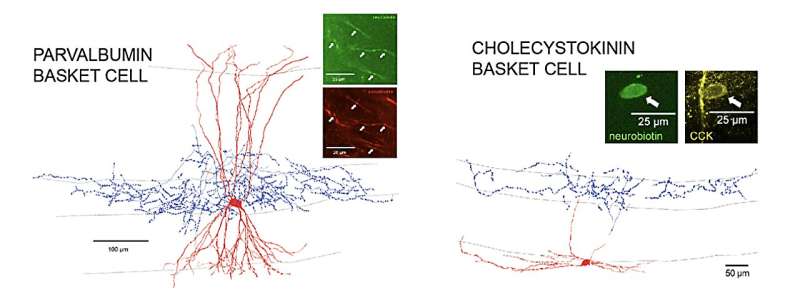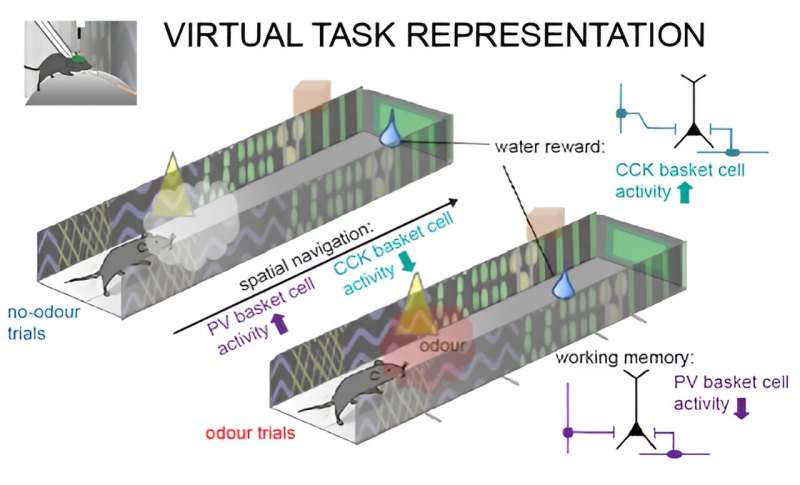September 13, 2023 feature
This article has been reviewed according to Science X's editorial process and policies. Editors have highlighted the following attributes while ensuring the content's credibility:
fact-checked
peer-reviewed publication
trusted source
proofread
Exploring the activity patterns of distinct hippocampal interneuron types during odor-guided spatial navigation

The hippocampus is a crucial brain region known to support the processing and storage of higher-level information, in the form of memories. In addition to allowing humans and animals to recall events that happened in the past, it plays a part in learning and behavioral adaptation.
Neuroscience studies have shown that some cells in the hippocampus represent an animal's position in space, linking it to past events or specific contexts. However, the role of specific types of GABAergic hippocampal interneurons in this process remains poorly understood.
Researchers at Medical University of Vienna recently set out to examine the activity of different hippocampal interneurons as mice were completing an odor-driven spatial navigation task. Their findings, outlined in Neuron, show that distinct types of interneurons fire differently while the mice are navigating an environment and remembering odors they smelled in the past.
"Previous work of Professor Thomas Klausberger and other researchers has revealed that neurons in the hippocampus express a high diversity, consisting of distinct neuron types," Thomas Forro, co-author of the paper, told Medical Xpress.
"Especially inhibitory neurons of the hippocampus, called GABAergic interneurons, show a great diversity in what inputs they integrate and how they target the principal cells of the hippocampus, the excitatory pyramidal neurons that transmit memories to other brain areas. We asked, how might this striking observation of cortical organization enable cognition underlying behavior?"
The key objective of the recent study by Forro and his colleague Thomas Klausberger was to better understand the contribution of the hippocampus' different inhibitory building blocks to the mental recall of associations between an odor and a meaningful spatial memory (i.e., where a reward could be found within a set environment). To do this, they conducted a series of experiments on mice, where the mice completed a spatial navigation task in the presence of carefully introduced odors.
The researchers used virtual reality (VR) solutions specifically designed for mice, and had the mice virtually navigate environments searching for food rewards. They also introduced odor cues in the mice's physical environment as a means to guide them towards the desired reward.
Meanwhile, the activity of interneurons in the mice's hippocampus was recorded using a technique known as juxta-cellular recording. This technique entails the use of a glass pipette with an electrode inside it to record the activity of an individual interneuron and 'label it' with a chemical marker.

"It has been shown previously and we also show in our study that pyramidal neurons of the hippocampus represent virtual space similar to real environments," Forro said.
"We recorded with silicon probes the activity of hippocampal neurons of the intermediate CA1 hippocampus, a subdomain of the hippocampus that has been hypothesized to be particularly important for the integration of sensory inputs. We show that principal neurons in this region are activated as virtual place cells in specific locations of the VR environment or are activated by sensory cues and reward and furthermore that the activity of some neurons relates to memory content depending on learned associations."
Using juxta-cellular labeling, Forro and his colleagues could visualize neural processes of interest (i.e., those filled with marker). They then used these visualizations to reconstruct dendrites and axons allowing them to identify the cell type of the recorded cells and better understand the activity of these distinct types of interneurons while the mice were completing the spatial navigation task.
Ultimately, the team was able to identify the activity patterns of three distinct types of interneurons in the CA1 region of the hippocampus. This included so-called parvalbumin expressing basket cells, parvalbumin expressing bistratified cells and cholecystokinin expressing basket cells.
"As animals and humans go through their everyday life, they are bombarded with sensory inputs, some of which could be predictive of important consequences related to, for example, good food sources, the meaning of traffic lights or road signs that many of us face on their way to work, etc.," Forro said.
"Our work suggests that as mice integrate a reward-associated sensory odor cue parvalbumin expressing basket cells that target the cell bodies (somata) and proximal dendrites of pyramidal neurons might contribute to the activity patterns underlying spatial working memory. Furthermore, another basket cell type that also targets somata and proximal dendrites of pyramidal neurons, but expresses cholecystokinin and not parvalbumin, might enable a general sensory integration during spatial navigation and contribute to representation of rewards."
This recent study suggests that to better understand the complex processes through which the brain encodes sensory information and pairs it to behavioral choices and events, one should examine distinct cell types in great detail. In fact, the team found that the different hippocampal interneuron types they examined had distinct activity patterns.
For instance, parvalbumin-expressing bistratified cells targeting more distal dendrites, rather than the of the cell bodies of pyramidal neurons in the hippocampus, were not differentially active while the mice recalled previously established odor associations. This suggests that the type-specific gating and modulation of information flow at different sites across pyramidal neurons translates into different functional implications of the interneuron cell types.
"We are just beginning to understand the interplay of excitatory and inhibitory activity at different levels, from general network states such as awake, rest, sleep to complex integration of information during spatial navigation," Forro said.
"With our study we aimed to add a piece of the puzzle showing that during complex behavior with navigation interneuron cell types might be recruited differentially and thereby play different roles and might represent distinct targets during mental disorders or in the creation of artificial neural networks. It will be of great interest to see how these cell types are contributing to activity patterns underlying other memories and even more complex natural behaviors to reveal what the general mechanisms of information processing in the hippocampus are."
The recent findings gathered by Forro and his colleagues contribute to ongoing efforts aimed at better understanding the role of the many different types of interneurons in the hippocampus. In the future, they could pave the way for further in-depth examinations using juxta-cellular techniques and other advanced recording and imaging methods.
"The juxta-cellular technique is a powerful method to relate the activity of individual neurons to their identity and is now being further utilized in Professor Klausberger's lab in Vienna to reveal differential contribution of cell types to decision making in the prefrontal cortex and during communications between different brain areas," Forro added. "In the lab of Professor Ciocchi in Bern we will also continue employing this technique in a virtual set up to discover distinct cell type contributions to emotional memories."
More information: Thomas Forro et al, Differential behavior-related activity of distinct hippocampal interneuron types during odor-associated spatial navigation, Neuron (2023). DOI: 10.1016/j.neuron.2023.05.007.
© 2023 Science X Network




















